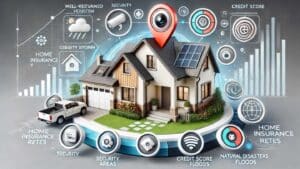Climate change is no longer a distant threat; it’s a pressing reality that’s profoundly affecting various aspects of our lives. One of the most tangible impacts is on homeowners insurance rates in the United States. As extreme weather events become more frequent and severe, homeowners are facing skyrocketing premiums and increased financial burden.
The Rising Frequency of Natural Disasters
Over the past few decades, the United States has witnessed a significant increase in the frequency and intensity of natural disasters. According to the National Oceanic and Atmospheric Administration (NOAA), the number of weather and climate disasters with damages exceeding $1 billion has been steadily rising. In 2020 alone, the U.S. experienced 22 such events, including hurricanes, wildfires, and floods. These disasters are a direct consequence of climate change, driven by global warming and environmental degradation.
Impact on Homeowners Insurance
The surge in natural disasters has had a profound impact on the homeowners insurance market. Insurance companies, facing mounting claims and higher payouts, have been forced to adjust their policies and rates. Homeowners in high-risk areas, such as coastal regions prone to hurricanes and areas vulnerable to wildfires, are particularly affected. In California, for instance, some homeowners have seen their premiums double or even triple in recent years.
Case studies highlight the severity of the situation. In Florida, which is highly susceptible to hurricanes, the average annual premium for homeowners insurance has increased by over 30% in the past five years. Similarly, residents in wildfire-prone regions of California are grappling with unaffordable premiums and, in some cases, outright denial of coverage.
Insurance Industry Response
To mitigate the financial risks associated with climate change, insurance companies are implementing several measures. These include:
- Adjusting Premiums: Insurers are increasing premiums for high-risk areas to cover the anticipated cost of claims.
- Revising Policies: Many companies are introducing new coverage options or exclusions related to natural disasters, such as separate deductibles for hurricane or wildfire damage.
- Investing in Predictive Models: Insurers are leveraging advanced technologies and predictive models to better assess risk and set premiums accordingly.
Impact on Homeowners
For homeowners, the financial implications are significant. Rising premiums can strain household budgets, making it difficult for some families to afford adequate coverage. Additionally, the increased risk of natural disasters can lead to higher out-of-pocket expenses when claims are denied or only partially covered.
Personal stories underscore the human impact of these changes. In Texas, a homeowner shared how her insurance premium doubled after a severe storm, leaving her to choose between paying for coverage or essential home repairs. Such stories are becoming increasingly common across the country.
Regulatory and Government Actions
In response to the growing crisis, state and federal governments are taking action. Some states, like California, have implemented regulations to prevent insurance companies from canceling policies in high-risk areas. Additionally, federal programs such as the National Flood Insurance Program (NFIP) are being expanded to provide more comprehensive coverage for flood-prone regions.
However, these measures are often seen as temporary fixes rather than long-term solutions. Policymakers are under pressure to develop more sustainable strategies to address the root causes of climate change and its impact on the insurance industry.
Future Projections
Experts predict that the situation will likely worsen before it improves. Climate models indicate that natural disasters will become even more frequent and severe in the coming decades. This will continue to drive up insurance costs and pose significant challenges for homeowners, insurers, and policymakers alike.
The long-term impacts on the housing market are also a concern. Areas with high insurance costs may see a decline in property values, making it difficult for homeowners to sell or refinance their homes.
Tips for Homeowners
Despite the challenges, there are steps homeowners can take to manage insurance costs and mitigate risks:
- Conduct a Home Risk Assessment: Understand the specific risks associated with your property and take proactive measures to reduce vulnerability, such as reinforcing your home against storms or creating defensible space to protect against wildfires.
- Shop Around for Coverage: Compare quotes from multiple insurers to find the best rates and coverage options.
- Review and Understand Your Policy: Ensure you fully understand your policy’s terms, including coverage limits, exclusions, and deductibles.
- Consider Flood Insurance: Even if not required, flood insurance can provide crucial protection, especially as flooding risks increase.
Let’s Review
Climate change is reshaping the landscape of homeowners insurance in the United States. As natural disasters become more frequent and severe, both homeowners and insurers are grappling with the financial fallout. While regulatory actions and industry adjustments provide some relief, long-term solutions are needed to address the root causes of climate change and ensure sustainable protection for homeowners. By staying informed and taking proactive steps, homeowners can better navigate this challenging environment and safeguard their properties against future risks.





